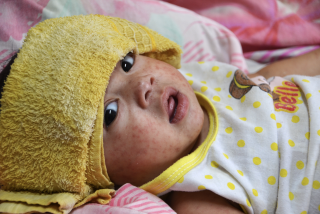Vaccine Could Quell Long-Lived Scourge in Time to Ease Aging of Baby Boomers
- Share via
WASHINGTON — Researchers are on the brink of perfecting a vaccine that may prevent shingles--a disease that most often afflicts the elderly and can produce blisters so painful that it has driven some to suicide.
The last phase of research, launched in June, could produce a marketable vaccine within five years--just in time for the first wave of baby boomers entering their 60s.
But because of the unusual nature of the virus, a form of herpes virus that enters the body in childhood to cause chickenpox and can stay dormant for decades until it returns with a vengeance as shingles, its prevention could have far-reaching effects.
Scientists believe that unlocking the secrets of shingles could provide a windfall of medical information about the workings of the body’s immune system and how it fights similar invaders, such as other herpes viruses, including those responsible for everything from oral and genital blisters and cold sores to infectious mononucleosis.
“There are many pieces of this puzzle, and this study will be a very good start in fitting them together,” said Dr. Myron Levin, a professor of pediatrics and medicine at the University of Colorado Health Sciences Center, the first researcher to demonstrate the safety and promise of the experimental shingles vaccine.
Virus Lives On for Decades
Shingles is caused by the Varicella zoster virus. After causing a bout of childhood chickenpox, it lives on in the nerves along the spinal cord, often for decades, held in check by the body’s immune system.
Eventually--usually when people get older and their immune systems decline--the virus erupts into painful blisters that can cover one side of the body or face, sometimes with serious complications such as blindness. The pain can last for months, even years.
“It’s severe enough to interfere with sleep,” said Dr. Philip Brunell, a former UCLA pediatrics professor who is now at the National Institutes of Health and is one of the lead investigators in the study. “Some people can’t even put on clothes. And the older you get, the worse the pain--and the longer it lasts.”
About 2 in every 10 people develop the disease, with 500,000 cases annually. The need for prevention will become more urgent within the next three decades, when more than 70 million Americans will be older than 65, and the 85-and-older population will be the fastest-growing segment in the nation.
Those who have had shingles report that the pain can persist for months, even years, long after the blisters have healed.
“It was so bad I didn’t want to wake up in the morning,” said Irvin H. Cohen, 83, a Baltimore bank executive, now retired, who suffered a lengthy episode when he was 70.
Most adults have been exposed to the Varicella zoster virus through chickenpox and to several other viruses in the herpes family.
Researchers announced in June that they plan to test the vaccine nationwide on 37,000 volunteers who are 60 or older. The trial is being sponsored by the Department of Veterans Affairs in collaboration with the National Institute of Allergy and Infectious Diseases and Merck & Co., developer of the vaccine. It will be conducted at 20 centers, including Denver, where Levin heads the study, and the VA hospital in San Diego, led by Dr. Michael Oxman.
The findings could provide the first comprehensive look at the natural history of the virus, one that traces its progress among a large generation of patients who have been harboring it for decades.
“We tend to focus a lot of attention on cancer and heart disease, and all too often we have neglected important and very common public health issues in older Americans,” said Dr. Stephen E. Straus, chief of the laboratory of clinical investigation at the allergy and infectious diseases agency. “This is one of them.”
A small group of 1,200 volunteers will be tested for immune system “markers”--cells that circulate in the bloodstream and are believed to be an indication of immunity to this virus.
Researchers now believe that increases in these cells translate into protection. “The number of these cells that exist in old people decreases over time, and the vaccine increases it,” Levin said.
Knowing the correct markers with certainty will speed the development of better vaccines, not only against Varicella zoster but possibly against other viruses as well, he said.
About 8% Haven’t Responded to Tests
Another group of volunteers will be studied for genetic and other factors that make them unresponsive to the vaccine. So far, in tests of earlier versions of the experimental shingles vaccine in humans, about 8% do not respond at all.
“Does that mean that these people might be at special risk for zoster?” Levin asked. “Maybe there are some people genetically constituted to not respond.” If the latest version of the vaccine has the same lack of effect, he said, “we can identify these people, we can study them intensively--focusing on their genetics--and try to understand why some people are nonresponders.”
The virus has long been a source of fascination to scientists, who continue to puzzle over its dynamics and the way the body’s immune system handles it.
No one completely understands what enables the body to keep it under control for so many years, although there are several theories.
Some experts believe that periodically the virus tries to reactivate itself and the body’s immune system, in response, receives a “boost” against the virus.
The result is to postpone shingles until the immune system begins to decline naturally through aging or through other factors.
Others think the immune “boost” historically may have come from the outside--that adults got immunity boosts after being exposed to their own young children who had contracted chickenpox.
Or it could very well be both: Young parents may get the benefit of exposure from their sick children and internally from themselves. Regardless of the reason, immunity against zoster tends to be strong throughout young adulthood and then starts to wane after age 50.
Risks Could Increase for Young Adults
If an immune boost largely comes from exposure to sick children, however, some experts think that the nation could see an increase of shingles in young adults in coming years. As the chickenpox vaccine now in widespread use reduces the incidence of chickenpox in children, fewer parents will be exposed to it.
Without such exposure, the virus could reactivate itself at an earlier age, a possibility that makes a shingles vaccine imperative, not just for the elderly.
Shingles in young adults is rare now, and the chances of its appearing increase dramatically with age.
Dr. Jane Seward, a Varicella expert at the national Centers for Disease Control and Prevention, said the agency will monitor the incidence of shingles over time to see if new patterns emerge, but it will take at least 20 years to see the first signs of a significant increase of shingles among young adults.
Most of the time, the disease is milder in young adults than in the elderly--but not always.
“I had the feeling that someone was trying to drive a railroad spike through my head,” said John La Montagne, 56, deputy director of the allergy and infectious diseases agency, who suffered an attack when he was in his early 30s.
He was afflicted with a version of shingles called Ramsey-Hunt syndrome, which is a reactivation of the virus along the facial nerve.
Within days, the right side of his face was paralyzed; it remained so for six weeks. Eventually, the condition improved, but it never completely disappeared. He still has trouble swallowing.
“The pain was intense, occurring in cycles where I was in agony for about 10 seconds,” he said. “It would abate for about 10 seconds, then recur. This lasted for well over two weeks. I can absolutely believe that people are driven to suicide by the pain. I still remember it--vividly.”






